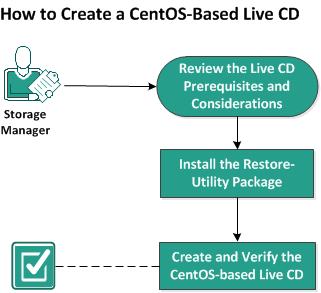How to Create a CentOS-Based Live CD
Important!
- To include custom drivers for Centos 8, which was made available from UDP 8.1 release, see How to Create a Bootable Live CD to Include Custom Drivers for CentOS 8.x.
- Follow the instructions given in this page if you want to include specific custom drivers for CentOS 7 with the recommended OS for the UDP 9.0 release.
- If you do not have any specific need to include custom drivers, then use the default liveCD (UDP_Agent_Linux-LiveCD.iso), which is available in 9.0 LBS for performing BMR on a target node.
As a storage manager, you can create a bootable CentOS-based Live CD. CentOS Live CD is an in-memory computing environment based on CentOS. The purpose of this Live CD is to provide users the capability to experience the CentOS functionality without installing CentOS. The Live CD runs in memory without impacting the hard disk. The changes that you make in the Live CD runtime environment are lost after you restart the machine.
This Live CD includes all your system settings and operating system files and can be used to perform the following functions:
- You can use Arcserve Unified Data Protection Agent for Linux without actually installing the product. This allows you to experience and evaluate the product without installing it or making any changes to the existing hard drive of your computer.
- You can perform a Bare Metal Recovery (BMR). You can use this Live CD to get the IP address of the target machine (which is required during the BMR).
When to use the CentOS-based Live CD:
When the default Live CD cannot identify storage device and network device because of the lack of the device driver.
Note: The recovery points that you want to restore does not include the device drivers for the storage system of the target BMR machine. As a result, Arcserve Unified Data Protection Agent for Linux will block any attempt to perform a BMR job at an early stage.
The bin folder contains the scripts that you can run from the command line to create a bootable Live CD. The bin folder is located in the following path:
# /opt/Arcserve/d2dserver/bin
The following diagram displays the process to create a CentOS-based Live CD:

Perform the following tasks to create a CentOS-based Live CD: